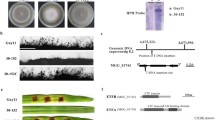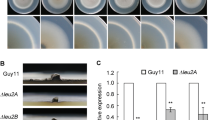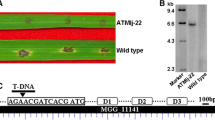Abstract
The rice blast fungus Magnaporthe oryzae forms a specialized infection structure called an appressorium to breach the host-plant epidermis for successful infection. In this study, a mutant defective in appressorial penetration was isolated by a mutagenesis approach, in which an exogenous DNA fragment was found to be inserted into the first exon of MoCRC1. This gene encodes a putative carnitine–acylcarnitine carrier protein that is widely conserved among eukaryotic organisms. Deletion of MoCRC1 severely reduces appressorium turgor generation, appressorial penetration, and development of infection hyphae. The null mutant of MoCRC1 lost pathogenicity on intact and abraded host leaves. MoCRC1 was also found to be required for growth on minimal medium containing sodium acetate or olive oil. Moreover, the transformed MoCrc1–eGFP fusion protein was expressed throughout the infection process. Our results suggest that the carnitine–acylcarnitine carrier protein plays vital roles in appressorium-mediated infection and is essential for pathogenesis of M. oryzae and perhaps other phytopathogenic fungi.







Similar content being viewed by others
References
Bhambra GK, Wang ZY, Soanes DM, Wakley GE, Talbot NJ (2006) Peroxisomal carnitine acetyl transferase is required for elaboration of penetration hypha during plant infection by Magnaporthe grisea. Mol Microbiol 61:46–60
Chen X, Yang J, Peng YL (2011) Large-scale insertional mutagenesis in Magnaporthe oryzae by Agrobacterium tumefaciens-mediated transformation. Methods Mol Biol 722:213–224
Christensen HT, Zhang ZG, Wei YD, Collige DB (1997) Subcellular localization of H2O2 in plants. H2O2 accumulation in papillae and hypersensitive response during the barley–powdery mildew interaction. Plant J 11:1187–1194
de Jong JC, McCormack BJ, Smirnoff N, Talbot NJ (1997) Glycerol generates turgor in rice blast. Nature 389:244–245
De Lucas JR, Dominguez AI, Valenciano S, Turner G, Laborda F (1999) The acuH gene of Aspergillus nidulans, required for growth on acetate and long chain fatty acids, encodes a putative homologue of the mammalian carnitine/acylcarnitine carrier. Arch Microbiol 171:386–396
De Lucas JR, Martinez O, Perez P, Lopez MI, Valenciano S, Laborda F (2001) The Aspergillus nidulans carnitine carrier encoded by the acuH gene is exclusively located in the mitochondria. FEMS Microbiol Lett 201:193–198
Dean RA, Talbot NJ, Ebbole DJ, Farman ML, Mitchell TK, Orbach MJ, Thon M, Kulkarni R, Xu JR, Pan HQ, Read ND, Lee YH, Carbone I, Brown D, Oh YY, Donofrio N, Jeong JS, Soanes DM, Djonovic S, Kolomiets E, Rehmeyer C, Li WX, Hardling M, Kim S, Lebrun MH, Bohnert H, Coughlan S, Butler J, Calvo S, Ma LJ, Nicol R, Purcell S, Nusbaum C, Galagan JE, Birren BW (2005) The genome sequence of the rice blast fungus Magnaporthe oryzae. Nature 434:980–986
Ebbole DJ (2007) Magnaporthe as a model for understanding host–pathogen interactions. Annu Rev Phytopathol 45:437–456
Gouet P, Courcelle E, Stuart DI, Metoz F (1999) ESPript: multiple sequence alignments in PostScript. Bioinformatics 15:305–308
Hamer JE, Howard RJ, Chumley FG, Valent B (1988) A mechanism for surface attachment in spores of a plant pathogenic fungus. Science 239:288–290
Hartenstein K, Sinha P, Mishra A, Schenkel H, Török I, Mechler BM (1997) The congested-like tracheae gene of Drosophila melanogaster encodes a member of the mitochondrial carrier family required for gas-filling of the tracheal system and expansion of the wings after eclosion. Genetics 147:1755–1768
Horton P, Park KJ, Obayashi T, Fujita N, Harada H, Adams-Collier CJ, Nakai K (2007) WoLF PSORT: protein localization predictor. Nucleic Acids Res 35:585–587
Howard RJ, Ferrari MA, Roach DH, Money NP (1991) Penetration of hard substrates by a fungus employing enormous turgor pressures. Proc Natl Acad Sci USA 88:11281–11284
Iacobazzi V, Naglieri MA, Stanley CA, Wanders RJA, Palmieri F (1998) The structure and organization of the human carnitine/acylcarnitine translocase (CACT) gene. Biochem Biophys Res Commun 252:770–774
Indiveri C, Iacobazzi V, Giangregorio N, Palmieri F (1997) The mitochondrial carnitine carrier protein: cDNA cloning, primary structure and comparison with other mitochondrial transport proteins. J Biol Chem 321:713–719
Kankanala P, Czymmek K, Valent B (2007) Roles for rice membrane dynamics and plasmodesmata during biotrophic invasion by the blast fungus. Plant Cell 19:706–724
Khang CH, Berruyer R, Giraldo MC, Kankanala P, Park SY, Czymmek K, Kang S, Valent B (2010) Translocation of Magnaporthe oryzae effectors into rice cells and their subsequent cell-to-cell movement. Plant Cell 22:1388–1403
Kong LA, Yang J, Li GT, Qi LL, Zhang YJ, Wang CF, Zhao WS, Xu JR, Peng YL (2012) Different chitin synthase genes are required for various developmental and plant infection processes in the rice blast fungus Magnaporthe oryzae. PLoS Pathog 8:e1002526
Kuan J, Saier MH (1993) Expansion of the mitochondrial carrier family. Res Microbiol 144:671–672
Lawand S, Dorne AJ, Long D, Coupland G, Mache R, Carol P (2002) Arabidopsis A BOUT DE SOUFFLE, which is homologous with mammalian carnitine acyl carrier, is required for postembryonic growth in the light. Plant Cell 14:2161–2173
Lu S, Lyngholm L, Yang G, Bronson C, Yoder OC, Turgeon BG (1994) Tagged mutations at the Tox1 locus of Cochliobolus heterostrophus by restriction enzyme-mediated integration. Proc Natl Acad Sci USA 91:12649–12653
Marcel S, Sawers R, Oakeley E, Angliker H, Paszkowski U (2010) Tissue-adapted invasion strategies of the rice blast fungus Magnaporthe oryzae. Plant Cell 22:3177–3187
Palmieri F (1994) Mitochondrial carrier proteins. FEBS Lett 346:48–54
Palmieri L, Lasorsa FM, Iacobazzi V, Runswick MJ, Palmieri F, Walker JE (1999) Identification of the mitochondrial cartinine carrier in Saccharmyces cerevisiae. FEMS Lett 462:472–476
Park G, Bruno KS, Staiger CJ, Talbot NJ, Xu JR (2004) Independent genetic mechanisms mediate turgor generation and penetration peg formation during plant infection in the rice blast fungus. Mol Microbiol 53:1695–1707
Peng Y, Shishiyama J (1988) Temporal sequence of cytological events in rice leaves infected with Pyricularia oryzae. Can J Bot 66:730–735
Perez P, Martinez O, Romero B, Olivas I, Pedregosa AM, Palmieri F, Laborda F, De Lucas R (2003) Functional analysis of mutations in the human carnitine/acylcarnitine translocase in Aspergillus nidulans. Fungal Genet Biol 39:211–220
Ramos-Pamplona M, Naqvi NI (2006) Host invasion during rice blast disease requires carnitine-dependent transport of peroxisomal acetyl-CoA. Mol Microbiol 61:61–75
Saitou N, Nei M (1987) The neighbor-joining method: a new method for reconstructing phylogenetic trees. Mol Biol Evol 4:406–425
Sambrook J, Russell DW (1989) Molecular cloning: a laboratory manual. Cold Spring Harbor Laboratory Press, Cold Spring Harbor
Saunders DG, Aves SJ, Talbot NJ (2010) Cell cycle-mediated regulation of plant infection by the rice blast fungus. Plant Cell 22:497–507
Schmalix W, Bandlow W (1993) The ethanol-inducible YAT1 gene from yeast encodes a presumptive mitochondrial outer carnitine acetyltransferase. J Biol Chem 268:27428–27439
Sesma A, Osbourn AE (2004) The rice leaf blast pathogen undergoes developmental processes typical of root-infecting fungi. Nature 431:582–586
Talbot NJ, Kershaw MJ, Wakley GE, de Vries OMH, Wessels JGH, Hamer JE (1996) MPG1 encodes a fungal hydrophobin involved in surface interactions during infection-related development of Magnaporthe grisea. Plant Cell 8:985–999
Tamura K, Dudley J, Nei M, Kumar S (2007) MEGA4: molecular evolutionary genetics analysis (MEGA) software version 4.0. Mol Biol Evol 24:1596–1599
Thines E, Weber R, Talbot NJ (2000) MAP kinase and protein kinase A dependent mobilization of triacylglycerol and glycogen during appressorium turgor generation by Magnaporthe grisea. Plant Cell 12:1703–1718
Valent B (1990) Rice blast as a model system for plant pathology. Phytopathol 80:33–36
van Roermund CW, van den Berg M, Tabak HF, Wanders RJ, Hettema EH (1999) Molecular characterization of carnitine-dependent transport of acetyl-CoA from peroxisomes to mitochondria in Saccharomyces cerevisiae and identification of a plasma membrane carnitine transporter, Agp2p. EMBO J 18:5843–5852
Veneault-Fourrey C, Barooah M, Egan M, Wakley G, Talbot NJ (2006) Autophagic fungal cell death is necessary for infection by the rice blast fungus. Science 312:580–583
Wang ZY, Soanes DM, Kershaw MJ, Talbot NJ (2007) Functional analysis of lipid metabolism in Magnaporthe grisea reveals a requirement for peroxisomal fatty acid β-oxidation during appressorium-mediated plant infection. Mol Plant Microbe Interact 20:475–491
Wilson RA, Talbot NJ (2009) Under pressure: investigating the biology of plant infection by Magnaporthe oryzae. Nat Rev 7:185–195
Xu JR, Hamer JE (1996) MAP kinase and cAMP signaling regulate infection structure formation and pathogenic growth in the rice blast fungus Magnaporthe oryzae. Genes Dev 10:2696–2706
Xu JR, Peng YL, Dickman MB, Sharon A (2006) The dawn of fungal pathogen genomics. Annu Rev Phytopathol 44:337–366
Xu JR, Zhao XH, Dean RA (2007) From genes to genomics: a new paradigm for studying fungal pathogenesis in Magnaporthe oryzae. Adv Genet 57:175–218
Yang J, Zhao XY, Sun J, Kang ZS, Ding SL, Xu JR, Peng YL (2010) A novel protein Com1 is required for normal conidium morphology and full virulence in Magnaporthe oryzae. Mol Plant Microbe Interact 23:112–123
Zdobnov EM, Apweiler R (2001) InterProScan—an integration platform for the signature-recognition methods in InterPro. Bioinformatics 17:847–848
Acknowledgments
We thank Professors Tom Hsiang and Paul H. Goodwin at University of Guelph and Larry D. Dunkle at Purdue University for their editorial assistance. This work was supported by a grant from the National Fundamental Basic Research program (2012CB114002) to Y.-L. Peng of the Ministry of Sciences and Technology, China, and by a grant from the China Postdoctoral Science Foundation to J. Yang (20100480505).
Conflict of interest
We declare that no conflict of interest exists.
Author information
Authors and Affiliations
Corresponding authors
Additional information
Communicated by C. D'Enfert.
Nucleotide sequence data reported are available in the GenBank database under the accession number ADB25056 (MoCRC1).
Rights and permissions
About this article
Cite this article
Yang, J., Kong, L., Chen, X. et al. A carnitine–acylcarnitine carrier protein, MoCrc1, is essential for pathogenicity in Magnaporthe oryzae . Curr Genet 58, 139–148 (2012). https://doi.org/10.1007/s00294-012-0372-8
Received:
Revised:
Accepted:
Published:
Issue Date:
DOI: https://doi.org/10.1007/s00294-012-0372-8




